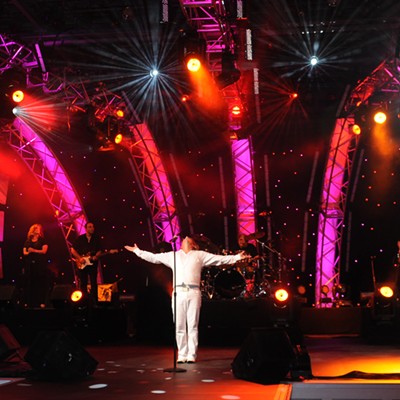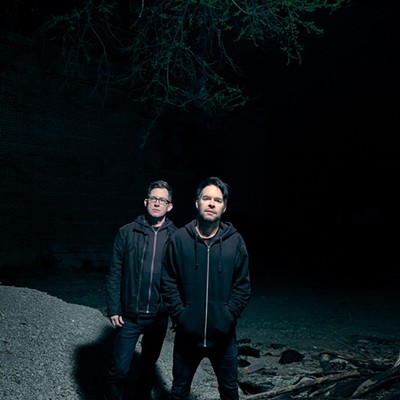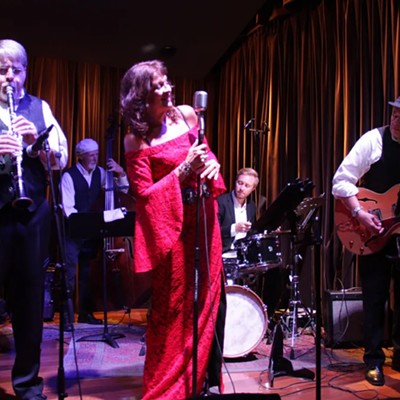One might argue that Bowerbirds make plein air music.
The "en plein air" practice of painting outside in natural light—a significant influence on impressionism, among other movements—got its start in the mid-19th century and is all about making art in the great wide open. That's exactly where frontman Phil Moore, 31, can be found when writing many of the tunes for the North Carolina-based Bowerbirds.
Moore and accordionist Beth Tacular, his life partner and a visual artist by calling, live relatively rural in an Airstream trailer, powered by one solar panel, in the North Carolina woods. Nearby, they are building a cabin from recycled lumber. He said many of the songs on Bowerbirds' two albums have been inspired by and initially created in the natural environment.
"That's kind of the main inspiration of the lyrics," he said. "If the song is not actually about something in the natural world, the song reflects an interest in the world around us. Most of the time, that is where the songs are written—out in the wilderness where I live."
Moore spoke to the Weekly over a surprisingly clear cell-phone connection while the band drove to a gig through the Cascade Range in British Columbia. The current tour will bring them to Tucson for a show at Club Congress on Monday, Aug. 10. The group will be joined by opening act and tourmates Megafaun.
For their 2007 debut full-length album, Hymns for a Dark Horse, and the recently released Upper Air, Bowerbirds have crafted an engaging take on folk music built from rough-hewn rock energy, catchy pop melodies and traditional Americana elements of blues and twang. The spare arrangements employ acoustic guitars, organ, piano, accordion, violin, autoharp, upright bass and various forms of percussion.
The resulting music has been compared to that of Richard and Linda Thompson, Devendra Banhart, Iron and Wine and the more restrained sides of Beirut and Blitzen Trapper.
Naturally, some critics are quick to label Bowerbirds as just another band in a pre-programmed musical category, so the group has been called nu-folk, freak folk and beard rock. But those appellations mean little to Moore and his compatriots.
"It's a way to explain that somebody's playing acoustic instruments in a context where people are only used to rock music," he said.
On Hymns, the first Bowerbirds album, the songs focused on the premise that the Earth is a sacred place and that the humans inhabiting it are merely temporary visitors. The new recording retains that sense of spirit and place but adds a deeply personal perspective, examining love and human experience.
In contrast, much of sophomore release Upper Air was created not in the isolation of the wild, but among other humans, as Moore and Tacular have circulated through society, sharing their music. Bowerbirds have been on the road much of the last year, playing with acts such as Bon Iver, Phosphorescent and John Vanderslice, in the United States and Europe.
Often, the music of Bowerbirds feels as if it has been dappled by forest sunshine, with a positive sense of joy and hope imbuing the melodies and lyrics. But Moore and company aren't unfamiliar with dark clouds, he said.
"Well, I wouldn't say (a rosy outlook) is the case for all the songs all the time, but, yeah, we pretty much look at the promise and positive nature of the things. I would say a good 75 percent of our songs are like that."
Moore and Tacular are the mainstays in Bowerbirds, but on the tour, they'll be joined by Mark Paulson on violin and percussion. Brad Cook, bassist for Megafaun, also will sit in.
Paulson is a childhood friend and former bandmate of Moore's in the group Ticonderoga, which released a couple of albums before Bowerbirds formed. After Ticonderoga disbanded, Tacular (born Beth Salmon) taught herself drums and accordion so she and Moore could pursue musical interests together. Thus was born Bowerbirds.
Considering the band's name, it's not surprising that Moore has worked at times as a bird tracker for natural-history museums and associations. After college, he lived and tracked the endangered Southwestern willow flycatcher on Lake Roosevelt in Arizona.
As a boy growing up in rural Iowa, Moore was taken with the jazz of Charles Mingus and the punk rock of several SST Records bands, such as Minutemen, Hüsker Dü and fIREHOSE.
"I took some piano lessons and was in the choir, but I never really got into playing music until I kind of latched on to playing the guitar," he said. "I wanted to learn all the chords, and really start playing serious jazz music, but I never got to the point where I was that proficient. And then I just kind of got into punk rock."
Moore is thinking a solo acoustic-guitar project bridging all of his interests—the Bowerbirds style, some avant-garde, maybe punky noise—might be his next step.
"I am thinking about it, but it's just very vague right now. I kind of want to go back to a little more stripped-down (style), maybe not even do it as Bowerbirds, just for myself. I'm kind of thinking like a David Grubbs/Gastr del Sol thing. I've been really into that lately."
Asked whether the open air might be the best place to enjoy the songs of Bowerbirds, Moore agreed—cautiously.
"That's where the songs were written a lot of the time, so that would not be a bad place to hear them. The ideal environment, if I have to be honest, is a nice art-gallery situation, with lots of creative vibes and maybe art around you. A good listening room with art—that's a suitable place for our band to play in."







